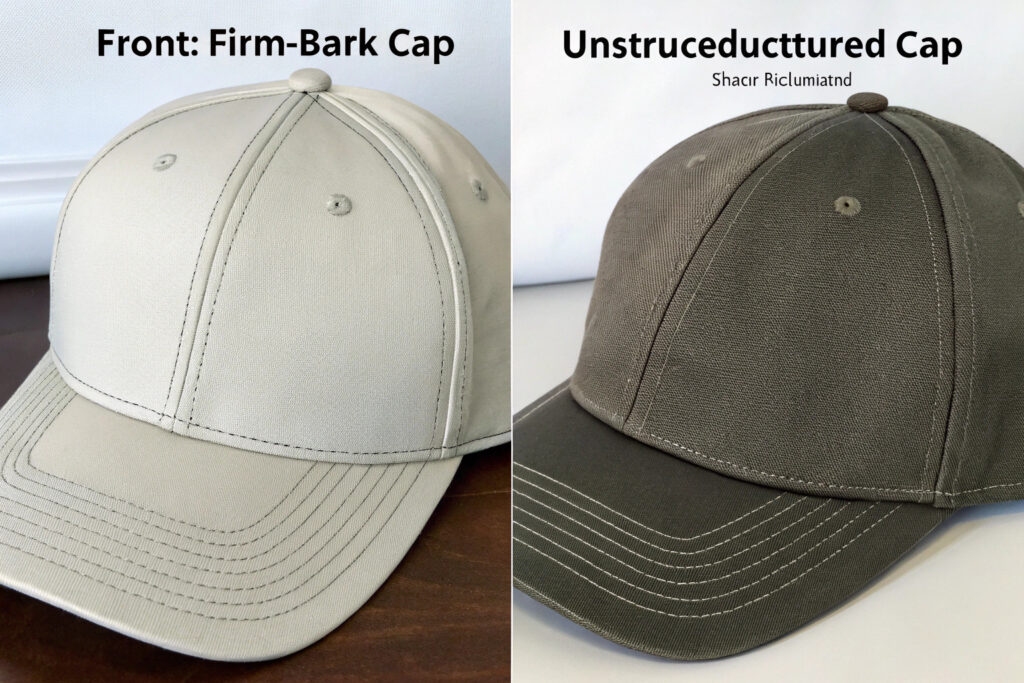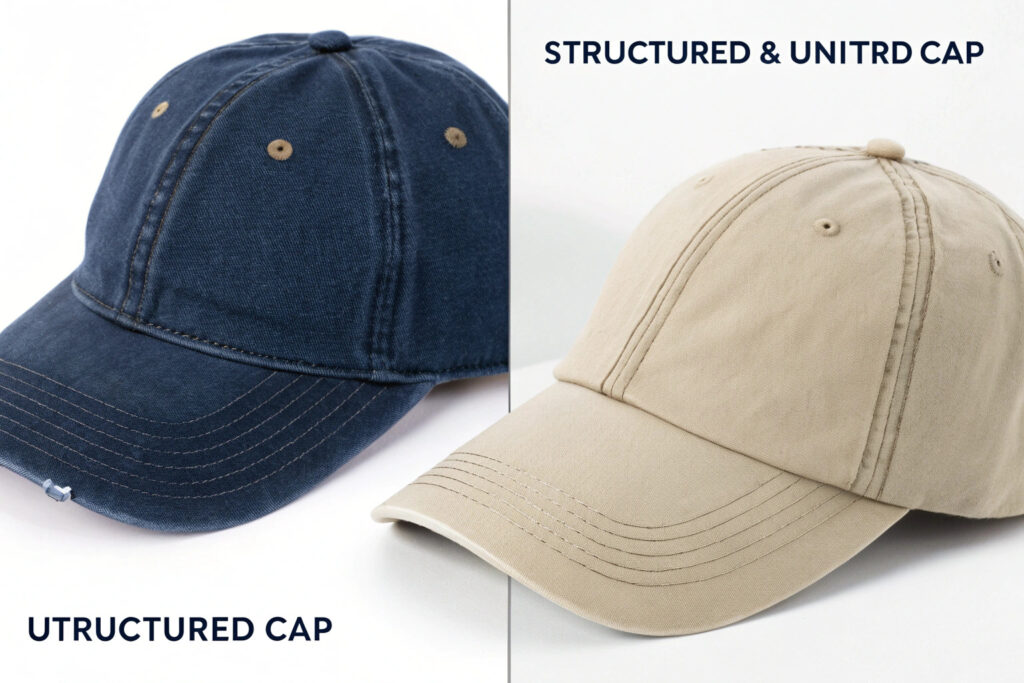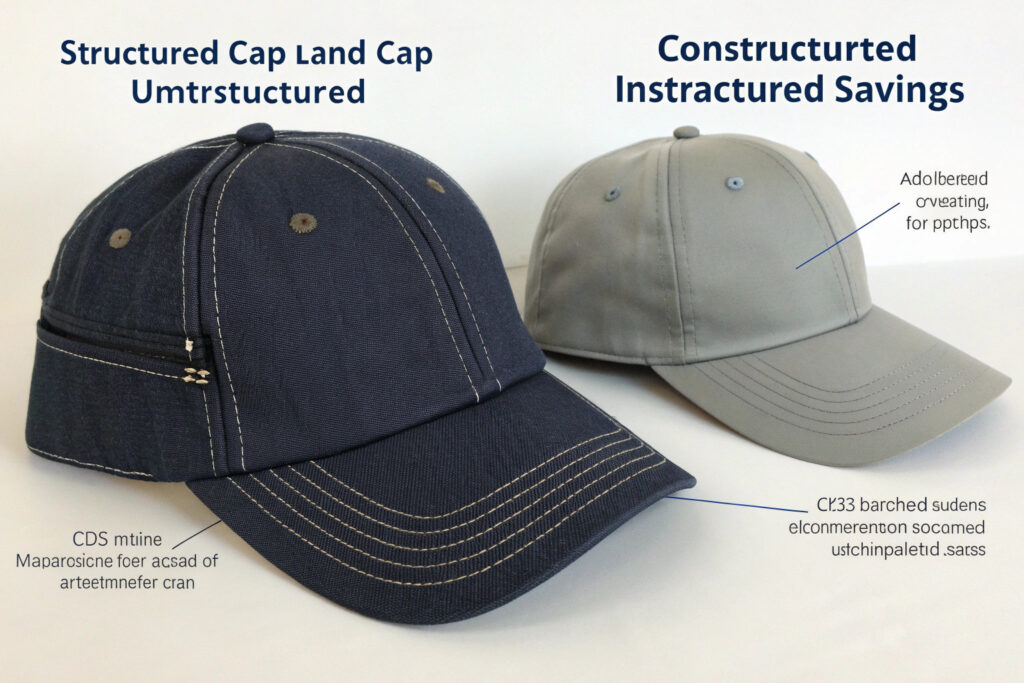The choice between structured and unstructured caps can make or break your brand's headwear line. Many buyers struggle with this decision, unsure which style aligns with their target market, brand identity, and comfort requirements. Selecting the wrong construction type can lead to poor sales and disappointed customers.
The choice between structured and unstructured caps depends on your brand's aesthetic goals, target audience preferences, and intended use cases. Structured caps offer a permanent, defined shape with front panel reinforcement, while unstructured caps provide a relaxed, broken-in feel with soft construction that molds to the wearer's head over time. Each style serves different market segments and occasions, making understanding their distinct advantages crucial for your buying decision.
This comprehensive guide will explore the construction differences, styling applications, comfort factors, and market positioning of both cap types to help you make an informed choice for your specific needs.
What are the fundamental construction differences?
Understanding the core construction elements is essential for making an informed decision. The structural components determine not only the cap's appearance but also its durability, comfort, and overall wearing experience.
The fundamental difference lies in the front panel reinforcement: structured caps feature firm buckram material sewn between fabric layers to maintain shape, while unstructured caps eliminate this stiffening material, creating a softer, more flexible construction that conforms to the wearer's head.

How does buckram affect cap structure and durability?
Buckram, a stiff woven fabric often stiffened with starch or synthetic resins, serves as the skeletal framework in structured caps. This material is strategically placed between the crown's front panels and visor, providing permanent shape retention that withstands repeated wear and washing. The buckram reinforcement ensures the cap maintains its intended profile regardless of handling or storage conditions. This construction method typically offers longer-lasting shape integrity, making structured caps ideal for situations where consistent appearance matters, such as uniform programs or branded merchandise where logo visibility is crucial.
What materials work best for each construction type?
The optimal materials vary significantly between structured and unstructured designs. Structured caps perform well with medium-weight cotton twills, polyester blends, and wool fabrics that complement the rigid framework. Unstructured caps excel with softer materials like pre-washed cotton, jersey knits, and lightweight technical fabrics that enhance their flexible, comfortable nature. At our manufacturing facility, we recommend brushed cotton and garment-washed fabrics for unstructured designs as they accelerate the broken-in feel, while recommending durable polyester-cotton blends for structured caps where long-term shape retention is prioritized.
Which style fits your brand's aesthetic and market?
Your cap's construction should align with your brand identity and target customer expectations. The wrong choice can create dissonance between your product and your brand message, potentially confusing your market.
Structured caps project professionalism, uniformity, and traditional appeal, while unstructured caps communicate casual comfort, modern fashion sensibility, and relaxed authenticity. Your selection should reinforce your brand's core values and positioning.

When should you choose structured caps for your brand?
Structured caps are the superior choice when your brand values consistency, professionalism, and traditional aesthetics. They work exceptionally well for corporate branding, team uniforms, promotional products, and any application where maintaining a sharp, consistent appearance is paramount. Structured construction ensures your logo remains prominently displayed with optimal visibility. If your target market includes older demographics, professional settings, or formalized group identities, structured caps typically resonate better. They convey establishment and reliability, making them ideal for financial institutions, service industries, and organizations where trust and professionalism are key brand attributes.
Which markets prefer unstructured caps?
Unstructured caps dominate in fashion-forward, youth-oriented, and lifestyle markets where comfort and casual aesthetics are prioritized. They're particularly popular in streetwear culture, creative industries, tech companies, and brands targeting millennials and Gen Z consumers. The relaxed, broken-in appearance communicates authenticity and approachability, aligning with brands that value individuality and comfort over formal presentation. Unstructured caps also perform well in warm climates where breathability and lightweight construction are appreciated. If your brand identity emphasizes authenticity, comfort, or modern casual style, unstructured designs will likely better resonate with your audience.
How does comfort and fit differ between styles?
Comfort is a primary driver in cap selection, and the structural differences significantly impact the wearing experience. Understanding these comfort variations helps match the right construction to your customers' needs and preferences.
Structured caps provide consistent, secure fit with defined crown space, while unstructured caps offer flexible, adaptive comfort that molds to individual head shapes. The choice often comes down to preference for stability versus softness.

Why do unstructured caps feel more comfortable initially?
Unstructured caps provide immediate comfort because they eliminate the rigid buckram that can create pressure points and require break-in periods. The soft crown construction conforms naturally to the wearer's head shape without resistance, distributing weight evenly and reducing hot spots. This makes them ideal for all-day wear, sensitive scalps, or situations where comfort takes priority over structured appearance. The absence of stiff materials also enhances breathability, as air circulates more freely through the soft fabric layers. For customers prioritizing comfort above all else, unstructured caps typically deliver superior immediate wearability.
How do structured caps provide better long-term fit consistency?
Structured caps maintain consistent fit and appearance over time due to their reinforced construction. The internal framework prevents the cap from losing its shape or becoming misshapen with repeated use. This dimensional stability ensures the cap looks the same on the hundredth wear as it did on the first, making it reliable for uniform applications where consistent presentation matters. The structured crown also provides more consistent interior space, accommodating various hairstyles without compression. For situations where the cap needs to maintain a professional appearance through extended wear or multiple users, structured construction offers superior longevity and reliability.
What are the price and production considerations?
Understanding the cost and manufacturing implications helps with budgeting and production planning. While the price difference may seem minimal per unit, it can significantly impact overall project costs at scale.
Structured caps typically cost slightly more due to additional materials and construction steps, while unstructured caps offer cost savings through simplified manufacturing. However, material choices and customization options can significantly influence final pricing for both styles.

Why do structured caps generally cost more to produce?
Structured caps require additional materials including buckram interfacing, extra stabilizers in the visor, and often more complex sewing operations to integrate these components properly. The additional labor time for precisely inserting and securing structural elements adds to production costs. Quality structured caps also typically feature reinforced stitching at stress points and more extensive quality control to ensure proper shape alignment. These factors combine to make structured caps approximately 15-25% more expensive to manufacture than their unstructured counterparts at similar quality levels, though this gap narrows with higher production volumes.
How can customization options affect pricing for both styles?
Customization complexity impacts pricing differently for each construction type. Structured caps typically accommodate embroidery more effectively, with the firm surface providing ideal stability for detailed logos and designs. Unstructured caps may require additional stabilizers during embroidery, potentially adding cost for customized versions. However, unstructured designs often work better with printing techniques and distressed treatments that align with their casual aesthetic. The cost implications depend on your specific customization needs—structured caps generally handle formal embroidery better, while unstructured caps may offer savings for printed designs or minimal branding approaches.
Conclusion
Choosing between structured and unstructured caps ultimately depends on your brand identity, target market, and intended use. Structured caps deliver professional consistency and traditional appeal ideal for corporate branding and uniform programs, while unstructured caps offer modern comfort and casual aesthetics perfect for fashion-forward and lifestyle applications.
At Global-Caps, we manufacture both structured and unstructured caps with equal expertise, helping our clients select the perfect construction for their specific market needs. Our design team can guide you through material selections, customization options, and production considerations to ensure your caps align with your brand vision. For personalized assistance in choosing between structured and unstructured caps for your next order, contact our Business Director Elaine at elaine@fumaoclothing.com. Let us help you create headwear that perfectly represents your brand.







